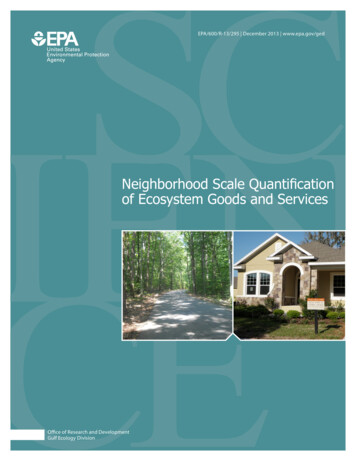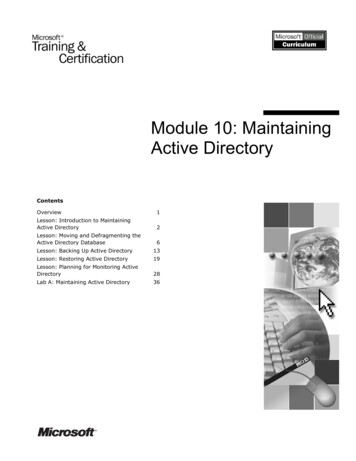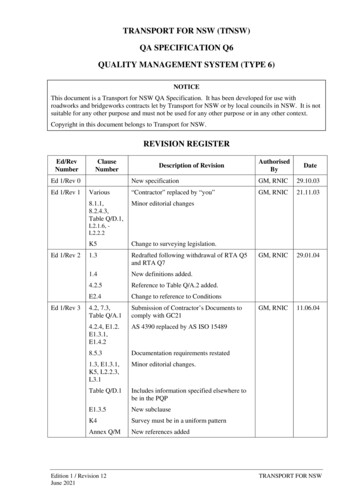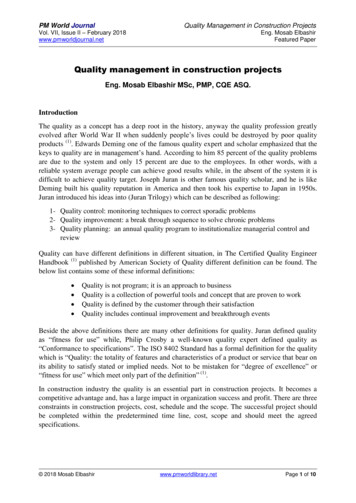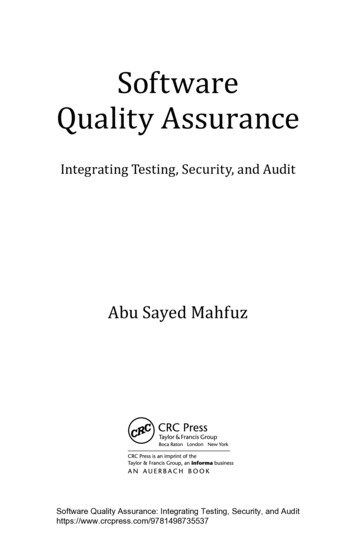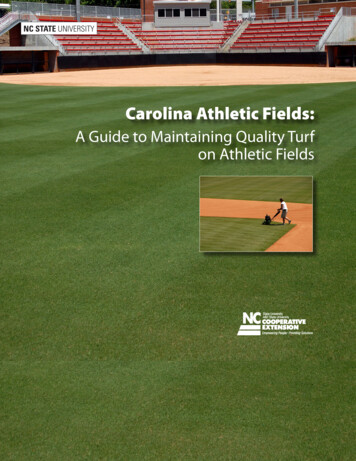
Transcription
NC STATE UNIVERSITYCarolina Athletic Fields:A Guide to Maintaining Quality Turfon Athletic Fields
Carolina Athletic Fields: A Guide to Maintaining Quality Turf on Athletic FieldsCarolina Athletic Fields:A Guide to Maintaining Quality Turf on Athletic FieldsCONTENTSIntroduction.3Maintaining an Established Field. 10IrrigatingMowingFertilizingCoring (Aerification)VerticuttingTopdressingField Dimensions.3Field Use Capacity.3Athletic Field Design.3What to PlantWinter-Kill ConsiderationsField DrainageMinimum Drainage RequirementsOverseeding . 12Overseeding TimingOverseed GrassesSeedingSpring TransitionTurf ColorantsEstablishing a New Field.5Site preparationClay SoilsFertilization and LimingDeep TillageFinal GradingSeedingSpriggingSoddingIntegrated Pest Management. 13WeedsInsectsDiseasesRenovating Damaged Areas. 14Caring for a New Field.8IrrigationFertilizationMowingPest ManagementTopdressing and RollingIrrigation SystemsCalendar Tables. 162
INTRODUCTIONSports fields play a pivotal role in recreational andcompetitive outdoor athletic activities. A quality playingsurface is appreciated by all participants, whether playing casual pick-up games or professional team sports,and produces a pleasing appearance to spectators. Inaddition, sports complexes are facing increasing legalquestions and liability regarding injuries associated witha poorly designed, constructed, or maintained facility. Tohave a quality turfgrass playing surface in all seasons ofuse, sports fields must have the following:(1) Adequate surface and subsurface water drainage.(2) A properly designed, installed, and maintainedirrigation system.Softball field includes turf as well as clay surface.ATHLETIC FIELD DESIGN(3) A vigorous, regular turfgrass maintenance programwith an appropriate turfgrass.Before construction, prepare a realistic timetable for everyoperation, from writing specifications and contractor bidsto field completion. Most people unacquainted with thework involved are surprised at the length of time neededto complete the planning and construction of a field—anywhere from a couple of months to two years, depending on project size, contractor experience, and weather.All athletic fields should be designed and constructedto meet standard dimensions of the game for which theywill be used. Contours and drainage provisions are veryimportant, as these provide for fast removal of surfacewater to maintain desirable playing conditions. If possible, orient fields to minimize time that players must lookdirectly into the sun during games. Generally, the longaxis of the field should be in a north-south direction,which also minimizes the field area shaded during thewinter months if there are trees along the south side ofthe field. A good design will provide an adequate irrigation system, drainage, and proper orientation of the field.(4) Reasonable play and field use.(5) Basic equipment.An unacceptable turfgrass stand often results whenone or more of these elements are omitted or whenuncontrolled or excessive play and traffic are allowed.Bermudagrass exhibits optimum growth during summermonths; however, with the onset of play and traffic in fall,along with soil compaction, the turf may become excessively worn. For this reason, some fields will be overseeded with a ryegrass to provide a wearable surface duringthe winter and early spring seasons.FIELD DIMENSIONSThe first step in developing a turfgrass management planis to understand the areas that make up the field. Thesefigures are needed to budget for items such as appropriate time and amount of product to be applied. Certainsports place heavy traffic on specific areas of the field.Soccer fields are heavily worn at the goal areas, whereasfootball tends to be played between the hash marks andthe 20-yard lines. Baseball and softball are played mostlyon skinned areas. A comparison of athletic field dimensions and relative field sizes is listed in Table 1.FIELD USE CAPACITYA common question relates to how much play a field canwithstand. Every effort should be made to accommodateall participating groups, but not at the expense of thefields. Information related to field use parameters can befound in extension publication AG-726 Maximizing theDurability of Athletic Fields.High-capacity football fields are constructed with a sand baseto have good internal drainage. Proper construction withdrain lines allows for a flatter field.3
Carolina Athletic Fields: A Guide to Maintaining Quality Turf on Athletic FieldsTable 1. Field dimensions and sizes of various sports ns (Feet)AreaGeneral Comments360L by 160W57,600 square feet (or1.3 acres)This 1.3 acres is within the sidelines. Outside the sidelines is typically 20or more feet or 30,000 square feet of space. Together these two areascomprise approximately 2 acres. Primary play is between the hash markswhich comprise about 20,000 square feet.90 betweenbases110,00 square feet (or2.5 acres total) withapproximately 11,500square feet of skinnedinfieldBaseball fields vary in size depending on the depth of the fences (300feet minimum fair line to 400 feet to center). A minimum of 12 feet inthe outfield and 8 feet around the stands is used for the warning track.Professional fields are usually 15 feet in the outfield and 12 to 15 feet infoul territory. The infield receives heaviest play. (Note: Little League, PonyLeague, and Babe Ruth League have smaller dimensions than listed). Seepublication AG-725 Baseball Field Layout & Construction.81,000 square feet (or1.9 acres)Soccer fields contain an average of 78,000 square feet with an additionalarea of 8,000 to 10,000 square feet along the sidelines, which receiveheavy traffic. A soccer field is larger than a football field, mostly in width,but soccer has many dimensions, depending on the age of the participants. Goal mouths, center field, referee sidelines, and the four cornerkick areas have highest wear.40,000 to 70,000square feetSlow pitch softball has an average fence depth of 300 feet and approximately 70,000 square feet of turf, depending on the sideline areas. Fastpitch softball fields have an average depth of 200 feet and approximately40,000 square feet of turf, depending on the sideline area. The 3 outfielder positions have most of the turf wear.360L by 225W65 betweenbasesWhat to PlantCurrently, the best and most often used hybrid bermudagrass for sports fields is Tifway (also called Tifton419). Other improved bermudagrasses sometimes foundon athletic fields include TifSport, Patriot, Celebration,GN-1, and Tifton 10. These grasses must be establishedvegetatively, most commonly by sprigs and less so byplugs or sod. The initial cost of these planting methodsis greater than seeding common bermudagrass; however, for the desired aesthetics, color, density, texture,and recuperative potential, these improved cultivars aresuperior to common bermudagrass.Seeded bermudagrasses (common bermudagrass) areused primarily because they can be established by seed,which is relatively inexpensive. However, one shouldrecognize that compared to Tifway bermudagrass, mostseeded bermudagrasses produce a lower quality surfacedue to their lighter green color, coarser leaf blades anddensity, unsightly stem and seedhead production duringsummer, and slower recuperative potential. Princess 77and Riviera are two cultivars that can be seeded and areof high quality, similar to the best vegetatively establishedcultivars. Riviera is also known for its excellent cold tolerance, as is the coarser textured Yukon.Other improved common bermudagrasses that havebetter color and density compared to the old ArizonaIt is best to consult with a state turf specialist or anestablished field construction contractor to discuss grassoptions. No one type of grass is best suited to all situations. A number of factors should be considered beforedeciding which grass to plant. Your decision should bebased on region, climate, intended use or wear at the site,and desired appearance. For the most part, NC fieldsare grassed with a bermudagrass. There are some exceptions in the mountains, but even in much of western NC,bermudagrass is often used on fields.Bermudagrass is desirable for athletic fields becauseit establishes quickly, withstands wear and traffic, andrecovers rapidly from injury. Bermudagrass is extremelydrought tolerant, grows rapidly on most soil types, andmakes a good turf surface if fertilized and mowed lowand often. Cultivar texture ranges from coarse to fine,and it forms a dense, durable surface when grown in fullsunlight.Most finely textured, high-quality turf-type bermudagrasses are planted using sod, sprigs, or plugs. Commonbermudagrass, which is the most coarsely textured, can beseeded. Several newer cultivars that have a medium texturecan also be seeded. Bermudagrass should be seeded at 1 to2 pounds per 1,000 square feet (45 to 90 pounds per acre).4
common bermudagrass include: Blackjack, Blue-Muda,Bradley, Burning Tree, Cheyenne, DelSol, Guymon,Jackpot, LaPaloma, LaPrima (a blend of certified bermudagrasses), Majestic, Mercury, Mirage, Mohawk, Panama,Paradise, Primavera, Primo, Pyramid, Sahara, Savannah, Shangri-La, Soliel, Sonesta, Southern Star, SR 9554,Sultan, Sundance II, Sundevil II, SunStar, Sultan, Sydney,Transcontinental, Yukon, and Yuma.Winter-Kill ConsiderationsFor those sports fields located in the upper piedmontand mountainous regions that are prone to winter lowtemperature injury, the choices for bermudagrass become more of an issue of survival rather than aesthetics.Midlawn, Midfield, Midiron, Patriot, Quickstand, andVamont are vegetatively propagated bermudagrass selections with increased cold tolerance primarily due to theirdeeper and more robust rhizomes. These selections alsotend to retain color longer in fall and green-up sooner inspring, and they are more vigorous in their growth andrecovery from damage or winter-kill. Yukon and Rivieraare seeded bermudagrasses with improved cold tolerance and playing characteristics. In addition, winter-killconsiderations determine which preemergence herbicideto use for crabgrass and goosegrass control. (See weedcontrol section for further details.)A smaller laser-guided dozer used to spread soil mix. Noteuse of silt fence and plywood to protect sub-surface layers.by traffic. To provide surface drainage, high school football fields should have a 12-inch crown for sandy soilsand 18 inches for clay soils from center to the sidelineor a 1 to 2 percent slope. Slope at the sideline may bereduced, but the area should not be flat. Surface watermovement in the areas where players stand is importantto prevent puddling.A minimum of four drainage tile lines should beinstalled, one running parallel to the center crown, typically down each hash mark, and the other set just off thefield along each sideline. Drain lines are usually 6 incheswide and 12 to 36 inches deep. Two inches of gravel isplaced at the bottom of the lines, a 4-inch perforateddrain line laid on top of this gravel layer, and pea gravel(¼ to ½ inch) or coarse sand is used to fill the trench tograde. The tile should not be laid within 4 inches of thesurface to prevent disruption from future aerifications.The tiles are laid on a continued ½ to 1 percent slope andare connected at their ends to allow water to drain awayfrom the field. Surface catch basins (or culverts) shouldalso be installed between the playing field and both sidelines (stands). These intercept surface drainage from thefield as well as water draining from the spectator stands.At least three (preferably four or more) catch basinsshould be considered for each side of the field. Similardrainage schemes can be developed for soccer, baseball, or other types of sports fields. It is suggested that acontractor be consulted before constructing a baseballfield due to the complexity of removing water from theinfields without flooding dugout areas.Field DrainageReasonable water drainage from a field is important tominimize event cancellations as well as to protect theintegrity of the field. Fields built with heavy native soilsdepend primarily on surface drainage to remove excesswater. These fields hold nutrients and have a high waterholding capacity, thus, require less fertilizer and water.They also provide good stability, shear strength, and traction. On the downside, most provide inadequate drainage and may compact easily. Perimeter drain lines areneeded to move surface run-off.Sand-based fields can be built essentially flat,not heavily crowned, and have high infiltration rates.Their internal drainage may be designed to move largeamounts of water away quickly. They have minimumcompaction but require more irrigation and fertilizationthan native soils, are usually more expensive to build, andmay be unstable until a mature root zone is established.ESTABLISHING A NEW FIELDSite PreparationMinimum Drainage RequirementsFor many high school and local municipal fields, surfacecontouring is the most effective and economical means ofproviding surface drainage. If insufficient sloping of thesurface occurs, water will stand (puddle), saturating thesoil, and the field can be easily compacted and damagedProper preparation prior to planting is critical to ensurethe establishment of a quality turf. Preparation will determine how quickly the grass becomes established andits long-term maintenance requirements. Soil should be5
Carolina Athletic Fields: A Guide to Maintaining Quality Turf on Athletic FieldsInstallation of turfgrass sod on football field.Clay areas of baseball fields require proper grading in relationto the turfgrass surfaces.prepared whether you are planting a new field or replanting an old one, and whether you are seeding or propagating vegetatively. The following steps provide a generalguideline for preparing an area for planting a sports field.square feet is sufficient to increase the pH of mostsandy soils one pH unit—for example, from pH 5.0to 6.0. For clay soils, 100 pounds per 1,000 square feetmay be necessary. Turf grown on alkaline soils (pHlevels greater than 7.0) often displays deficiencies inminor nutrients such as iron and manganese. Furtherdetails on soil pH adjustment can be obtained fromthe Cooperative Extension Service in your county.Based on soil test analysis, fertilizer should be applied to correct nutrient level deficiencies in the soil.If phosphorus is deficient, a fertilizer high in phosphorus (such as 0–20–0) should be added prior toplanting. Potassium also should be added, if needed,prior to planting. A starter fertilizer (fertilizer withhigher P content than the other nutrients) shouldbe used at the time of establishment with vegetativeplantings, but delayed until after germination if thearea is seeded. Apply a fertilizer based primarily onsoil test results and local product availability. A general recommendation is to use a turf-type fertilizer in4:1:2 or 3:1:2 ratios with micronutrients. Apply at arate of 1 pound soluble nitrogen per 1,000 square feet.1. Clean and Rough Grade. Remove all construction debris, brush, large roots, rocks, weeds, and oldtree stumps. If extensive grading is needed, removethe topsoil and stockpile it for replacement afterthe rough grade is established. The site should becrowned 1 to 2 percent (½- to 1-foot fall per 50 feet)toward the sidelines. The rough grade should conform to the final grade after the topsoil is replaced.Poorly-drained soil may require the installation ofdrainage lines. Install them in a trench with at least a1 percent fall for drainage. Seek professional adviceif uncertain about the type and installation procedure. Perennial weeds should be controlled duringsite preparation. Several applications of a nonselective herbicide such as glyphosate (Roundup Pro) plusfluazifop (Fusilade II) may be necessary for completeweed control. Hard-to-control weeds may require theservices of a professional.2. Soil Analysis. A soil analysis should be taken beforeplanting. A representative soil sample can be submitted to NCDA Soil Testing service or to a private lab.A soil test will determine the pH value, and the reportwill indicate whether pH adjustment is necessary. Thedesired range of soil pH for bermudagrass is 6.0 to6.5. Values below 5.0 and above 7.0 can restrict rooting and specific nutrient availability. If the soil is tooacidic (pH too low), dolomitic limestone (dolomite)is recommended for increasing soil pH. Applicationshould be based on a lime requirement that considers both soil buffering capacity and soil pH value. Inlieu of a lime requirement analysis, the applicationof 1 ton of dolomite per acre or 50 pounds per 1,0003. Installation of Irrigation Equipment. The irrigationsystem should be designed by an irrigation specialist and installed according to design specifications. Apoorly designed or improperly installed system willnever operate satisfactorily. Operation must be in amanner consistent with sound principles of turfgrassculture.Clay soilsFor heavy clay soils, sand can be added to improve physical properties. However, enormous amounts are typicallynecessary for a positive response. Typically, in a piedmont clay soil, up to 90 percent sand is required to make6
significant improvement in desirable soil characteristicssuch as drainage and air exchange. The sand used shouldalso contain at least 75 percent of its particles in themedium-sized range to improve soil aeration and drainage. In reality, unless enormous amounts of sand areprovided, fields consisting of clay soils are better off notbeing amended with sand. In lieu of sand, an organic material may be applied and incorporated prior to planting.In some instances a drier surface may be obtained with a3- to 6-inch sand cap after construction.per acre). Higher seeding rates usually result in weakenedstands as inter-competition among seedlings is excessiveand seedlings become spindly and weak. Turfgrass seedsare generally planted using either a mechanical seeder(also called a slit seeder), gravity flow drop seeder, rotary(or centrifugal) spreader, or hydroseeder. After planting,seeds are lightly incorporated into the top ¼-inch of theseedbed and the seedbed is firmed with a roller. Mechanical or slit seeders make a small furrow, drop seed into thisfurrow, cover the seed with approximately ¼-inch of rootzone mix, and firm the seedbed by rolling.Warm-season turfgrasses are normally seeded inlate spring or early summer when soil temperatures arebetween 70 and 80 F. Earlier seeding of warm-seasonturfgrasses will delay their germination until soil temperatures reach the required germination range and maylose some of their viability. Planting too late may notallow sufficient plant maturity before cooler fall temperatures and shorter daylight days slows growth.Fertilization and LimingApply the amounts of fertilizer and lime recommendedby the soil test and work these into the upper 4 to 6 inches of soil. A general starter-type fertilizer contains higheramounts of phosphorus and is needed for establishmentby turfgrass seedlings, while a slow-release nitrogensource is recommended prior to planting.Deep TillageSpriggingRototilling loosens compacted soil and improves thespeed and depth of rooting. If soil amendments, lime, ora basic fertilizer have been added in the preceding steps,it is necessary to till the soil as deeply as possible, preferably 6 to 8 inches. A tractor-mounted or self-propelledrotary tiller will do an adequate job of tilling the soil,especially if used in several directions prior to planting.Sprigging is simply the process of broadcast plantingbermudagrass stems (rhizomes and stolons, referred toas sprigs). They can also be planted in narrow spacedfurrows. Sprigs have little to no soil associated with them.Sprigging is considered to be the most economical meansof vegetative turfgrass establishment. Best survival is byplanting sprigs within 48 hours of harvest. Sprigs shouldbe watered immediately after planting, and wateredseveral times daily for several weeks until the turfgrassestablishes a root system. Do not sprig more area thancan be immediately watered. Generally, turfgrass sprigswill cover and become established within 6 to 16 weeksafter planting. The length of time for establishment depends on the sprigging rate, time of the year planted, andmaintenance practices implemented after planting.Broadcast sprigging involves spreading sprigs overthe area (like mulch) either by hand or by specializedmechanical equipment. After spreading, sprigs are thencut (or pressed) into the soil with a light disc, coveredwith ½-inch of topdressing, and then rolled to firm theseedbed to ensure sprig to soil contact. Sprigs are thenimmediately watered. This method of sprigging providesvery fast coverage and establishment of the turfgrass.However, since sprigs are planted at a shallow depth, theyare susceptible to drying out. Light, frequent irrigation(4 to 6 times daily) should be provided until the turfgrassroots become established (2 to 4 weeks).Final GradingFinal grading just prior to planting provides a smoothplanting bed. The site can be hand raked and draggedwith a hand-pulled drag such as a brush attachment ormetal door mat. Large areas can be smoothed by tractordrawn laser equipment with a tiller rake or grading box,and then hand-finished. Soil particles should be no largerthan golf-ball size, and smaller is even better. To achievea uniformly firm planting bed and to reduce erosion,loose soil can be compressed with a water ballast roller.Take care not to add too much weight and cause soilcompaction. Grass cannot develop a root system in aneroded or bulldozed soil, which becomes extremely hardand compacted. Irrigation can be used to settle the soilbefore planting. Hand raking to break up a crusty surfacemay be necessary prior to seeding.SeedingSeeding normally is cheaper compared to vegetativeplanting methods; however, the time for establishmentwith seeding exceeds the time from vegetative means, andthe area may be more prone to erosion and weed invasion. A general guide for seeding bermudagrass is to apply1 to 2 pounds of seed per 1,000 square feet (or 45 to 90 lbsSoddingSodding provides instant grassing and excellent soilerosion control. Sodding, however, is more expensive7
Carolina Athletic Fields: A Guide to Maintaining Quality Turf on Athletic Fieldsinitially and can introduce different soil types or pestssuch as nematodes, weeds, or fire ants, from the harvested field into the root zone. As a minimum specification,sodding should be utilized for areas prone to soil erosion,such as steep slopes and areas surrounding culverts andirrigation heads.Before installing sod, the seedbed should be watered.The sod should be installed soon, preferably within 48hours, after harvest. Edges of the sod should butt againsteach other tightly without stretching. Avoid gaps or overlaps by using machetes or sharp knives to trim aroundcorners and edges. Joints between the sod should bestaggered in a brick-like fashion so none of the edges ofadjacent pieces of sod are parallel. After installation, thesod should be rolled to ensure evenness and smoothnessand immediately watered heavily to wet the entire depthof the sod and top portion of the rootzone. Topdressingshould be implemented to fill in creases and low piecesand to help conserve moisture. Although sodding produces an almost instant green turf, it should be allowedto knit-down (or root) before subject to traffic and play.Four weeks is generally the minimum time necessaryfor this during periods of active turfgrass growth, longerwhen the turfgrass is not actively growing. One shouldnot be able to lift the sod if it is fully rooted.Irrigation of newly installed turfgrass. The use of “big gun”irrigation provides quick coverage and removes heads fromthe playing surface.a starter fertilizer with a 1-2-2 ratio of N-P-K or similarshould be incorporated into the soil mix. The nitrogensource should be slow release and applied at the equivalent of 1 lb N/1,000 square feet. This should providebetween 1½ to 2 lbs P per 1,000 square feet. After planting, the new seedlings should be fertilized approximately2 to 4 weeks after seeding, or as a general rule, afterthe second mowing. A complete fertilizer (one whichcontains N-P-K nutrients) designed specifically for useon turfgrass should be applied at an equivalent rate of 1pound of nitrogen per 1,000 square feet of turfgrass. Forbermudagrass sprigs, 1 lb N per 1,000 square feet appliedevery 7 to 10 days provides quickest establishment. Withbermudagrass, a quick release fertilizer such as ammonium sulfate (21-0-0) or urea (45-0-0) should be alternatedwith each application with a 1-2-2 ratio fertilizer (such as5-10-10, or equivalent). If additional color is needed or ifgrowth slows, supplement these fertilizations as neededwith a liquid nitrogen application at a rate of 1/5 lb nitrogen per 1,000 square feet. Potassium and phosphorusshould be added with each alternate nitrogen applicationin a balanced ratio until establishment.CARING FOR A NEW FIELDIrrigationProper water management is critical for the first several weeks after turfgrass planting. To prevent dryingof planting material, keep the top 1.5 inches of the soilmoist. This may require light watering two or three timesa day for 7 to 30 days. As the seedlings grow and root,water less often but for longer periods. Do not makethe mistake of decreasing water as soon as the seedlingsappear. Continue watering until the seedlings emerge.After the third mowing, water to a depth of 6 to 8 inchesabout once a week or when needed. Turfgrass establishment from sprigging, stolonizing, or plugging requiresconstant moisture due to the lack of soil associated withthese vegetative materials. In contrast, sod requires theleast amount of water because soil associated with sodprovides some moisture. Irrigation or watering shouldcontinue on a frequent basis to maintain a moist soilsurface for the vegetative plantings. Frequent surfaceirrigation should be continued for a two- to three-weekperiod or until establishment occurs.MowingBegin mowing as soon as the grass is 50 percent higherthan the desired height. A common mistake with mowing is waiting too long to mow the first time after planting. Proper mowing promotes lateral growth and plantmaturity. Mowing of the newly established turfgrassesshould begin as soon as the ground will support a mower.Mow fields when the bermudagrass reaches 1½ to 2inches, then reduce the height over time as the turfgrassbecomes established. It is imperative to use sharp bladesto prevent turfgrass seedlings from being torn or pulledup during mowing. The best-quality cut can be achievedFertilizationProper fertilization is essential for plant growth anddevelopment after seed germination. Prior to planting,8
Vegetative planting operations disturb the soil,which can promote germination and establishment ofweeds during grow-in. In addition, an ample supplyof moisture and fertilizer provides optimum growingconditions for weeds as well. Preemergence control ofannual grass weeds such as crabgrass and goosegrasswithout impeding new turfgrass growth can be achievedby applying a herbicide containing oxadiazon (such asRonstar). Research has shown that, if weeds are present, bermudagrass can be established more quickly withthe use of oxadiazon. Oxadiazon products should beapplied before or immediately after vegetative plantingat the recommended labeled use rate. Postemergencecontrol of grassy weeds in bermudagrass is by MSMA(not labeled after 2011) or quinclorac (Drive). Normally, these products can safely be used six to eightweeks after turf seeds germinate. Postemergence controlof seedling broadleaf weeds requires light rates of 2,4-Dalone or mixed with MCPP, 2,4-DP, MCPA, clopyralid,carfentrazone,dicamba or metsulfuron (Manor, Blade,MSM, etc.). Trifloxysulfuron (Monument), bentazon(Basagran T/O), or halosulfuron (Sedgehammer) helpcontrol nutsedges.Hand pulling or “roguing” will suffice if only a fewweeds are present; however, if many weeds emerge,selective postemergence applied herbicides may berequired. Consult herbicide labels for guidelines for application during establishment.Using a reel mower to provide a superior quality playingsurface and to stripe the field.with a reel mower. But in many circumstances, a wellset-up rotary mower can provide an acceptable cut. Mowduring midday when the turfgrass is dry. Turfgrass clippings should be returned to the soil surface for the firstcouple of mowings to promote rooting of any stolonswhich may have been cut during mowing.Pest ManagementWhen establishing new turfgrass areas, pest problemssuch as diseases, insects, and weeds must be minimized.This is best accomplished utilizing a preventive pest management strategy coupled with routine pest monitoring.As previously mentioned, irrigation or wateringis required to achieve seed germination and turfgrassestablishment; however, excessive irrigation can contribute to the development of disease problems.Most fungal pathogensrequire free water or veryhigh humidity in order toinfect a turfgrass plant.Irrigating in the eveningbefore dew forms or inthe morning after dewevaporates extends theduration of leaf wetnessand increases the risk ofdisease outbreaks. TurfPulling a large plug to checkgrass seedlings, thereroot health and scouting forfore, should be wateredpests.when dew or moistureis already present, such as in the predawn hours. If irrigation must be applied multiple times per day, ensurethat the lea
Professional fields are usually 15 feet in the outfield and 12 to 15 feet in foul territory. The infield receives heaviest play. (Note: Little League, Pony League, and Babe Ruth League have smaller dimensions than listed). See publication AG-725 Baseball Field Layout & Construction. Soccer 360L by 225W 81,000 square feet (or 1.9 acres)


